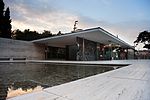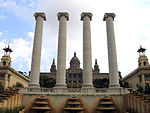Avinguda de la Reina Maria Cristina
Sants-MontjuïcStreets in Barcelona

Avinguda de la Reina Maria Cristina (Catalan pronunciation: [əβiŋˈɡuðə ðə lə ˈrejnə məˈɾi.ə kɾisˈtinə]) is an avenue in the Sants-Montjuïc district of Barcelona linking Plaça d'Espanya with Museu Nacional d'Art de Catalunya on Montjuïc hill. It is named after Maria Christina of the Two Sicilies, queen consort and regent of Spain. Part of the Fira de Barcelona is based here, with a number of yearly trade, technology and fashion fairs and festivals being held in this location. It's also the starting point of the Barcelona Marathon. The twin Venetian Towers are a major landmark at the junction of this avenue with Plaça d'Espanya.
Excerpt from the Wikipedia article Avinguda de la Reina Maria Cristina (License: CC BY-SA 3.0, Authors, Images).Avinguda de la Reina Maria Cristina
Avinguda de Rius i Taulet, Barcelona
Geographical coordinates (GPS) Address Website Nearby Places Show on map
Geographical coordinates (GPS)
| Latitude | Longitude |
|---|---|
| N 41.3729 ° | E 2.1506 ° |
Address
Fira de Barcelona
Avinguda de Rius i Taulet
08001 Barcelona
Catalonia, Spain
Open on Google Maps










